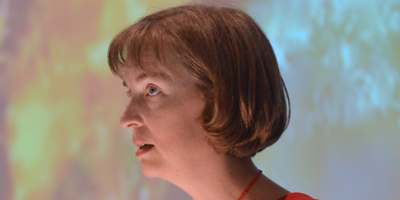In her inaugural lecture, Prof Helene Strauss explores symbols that reflect our history
|

|
Prof Helene Strauss
The burning tyre – image of promise and disappointment
Photo: Stephen Collett |
Prof Helene Strauss did not disappoint in her highly-anticipated inaugural lecture “The Spectacles of Promise and Disappointment: Political Emotion and Quotidian Aesthetics in Post-transitional South Africa”. She posed some very challenging ideas on the promises and disappointments that arouse from apartheid. Prof Strauss pointed to the fact that “… a promise must promise to be kept; that is, not to remain spiritual or abstract, but to produce events, new effective forms of action, practice, organisation, and so forth.”
She underscored the message of her lecture by making use of the image of a burning tyre – a symbol commonly associated with apartheid. This act of ‘necklacing’ is closely connected to the violence and protests of that era. Prof Strauss used this image to represent an array of social concerns: global mass protest, modernity and mobility, waste economies and waste management, environmental destruction, as well as poverty and resistance in varied formats.
Some of South Africa’s greatest artists have used the burning tyre in their work, particularlyBerni Searle and Zanele Muhloi. Not only does it trigger the shadow of the damaging past, but “more recently, it has come to figure also in the spectacles of promise and disappointment that have marked the country’s transitional and post-transitional periods,” Prof Strauss remarked.
Prof Strauss focuses her research on these symbolisms in our history because of “the questions that they raise about the emotional cultures produced in the aftermath of apartheid and for the unique contribution that they make to current debates on political and aesthetic activism.”Her passion for this subject comes from the “affective or emotional legacies of various forms of structural inequality, an interest that owes a sizeable debt to postcolonial, queer and feminist critical theory and creative work of the past hundred or so years.”
Prof Strauss accepted a position at the University of the Free Sate in 2011 and currently works in the Department of English. She is part of the Vice-Chancellor’s Prestige Scholars Programme and holds a PhD from the University of Western Ontario. Previously, she held the position of Assistant Professor in the Department of English and Cultural Studies at McMaster University in Canada, where she resided for 11 years.
Among the guests were Prof Jonathan Jansen, Profs Botes and Witthuhn, lecturers in the Department of English, members of the Faculty of the Humanities, students and some of Prof Strauss’ colleagues from Canada.